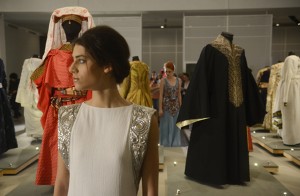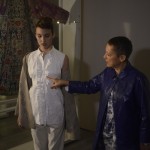FEATURES Discovering Jewish Identity in the Wardrobe
In front of me I see a black burqa adorned with a cream colored facial net. It comes from a Jewish community in Afghanistan and it dates back to nearly two centuries ago. It’s one of the garments typically worn by Jewish Arab women of that time. Next to the burqa stand a model, a fashion designer, two huge spotlights, and tens of photographers. The model parades as if she were on a catwalk, when she actually is in a museum. She is wearing a garment that could easily be considered the Afghani burqa’s grandchild – a piece that, despite the wide shape and the solid black, manages to stress the model’s silhouette.
The whole scene may appear to be juxtaposition, but it represents a new way of conceiving the relationship between old and new, ancient and modern. In fact, we find ourselves at the Israel Museum in Jerusalem, on the press tour of the temporary exhibition Dress Codes: Revealing the Jewish Wardrobe. A hundred pieces are displayed, collected from all over the world and selected from a collection of ten thousand garments. Although most of them date back to the 19th century, they are everything but archeological remains, since they represent a history that has carried through to today – the history of the Jewish wardrobe in the diaspora. It all started in India, Iran and Europe, and continues in the modern era with the renowned Israeli fashion scene.
Efrat Assaf-Shapira and Daisy Raccah Djivre, the curators of the newly launched exhibit have constructed a revival of the past and have revolutionized the idea of “museum” with an exclusive project presented on the press tour. They decided to gather six of the most important and distinguished Israeli fashion designers and assigned each a different garment from the exhibition with the task of creating a modern interpretation of the piece. Stylist Maya Kramer then gave life to the project, remaining in contact with the designers and following their creative process. “The most exciting part was seeing how the designers each interpreted differently what they saw”, she told me. Fashion is probably not one of the main subjects that we associate with Jewish history but is undoubtedly part of a cultural and artistic heritage that has left a mark in several countries. Along with the influence of the surrounding societies, the style of the Jewish people often influenced the gentile communities. It is a bilateral phenomenon that allowed a great spread of values and ideas.
“Today fashion is treated in a very commercial way – it’s a fast world”, explained Ilana Efrati, who created a piece for the exhibition which represents the typical fusion of cultures and identities in the Jewish diaspora. Fashion today might be based on ephemeral and occasional phenomena, but Ilana calls herself a “radical” and has always gone against the flow. Inspired by the lifestyle of Italy – which she experiences every other month since purchasing a house in the rural region of Umbria – she has created the idea of “slow fashion,” a style meant to be seen as durable. Alternating between the Tel-Avivian, urban frenzy and the Umbrian, unspoiled landscape, Ilana Efrati managed to find a balance that seems to be inspired by the ancient garments displayed at the Israel Museum. It is easy to forget that our culture, our influences, and our fashions are the result of a centuries-long history – Dress Codes, though, acts as a memorandum and reminds it to us in a brilliant and subtle way.
I see a clear intimate bond between the antique and modern pieces displayed side by side. Some garments stand out – a Victorian influenced Indian dress, the Ottoman Rabbi’s robe, and a Persian wedding gown that was inspired by the French ballet’s tutu. The tie with the religious rite is undeniable, too. In the Jewish communities of the Ottoman Empire, for instance, the custom was to donate to the synagogues the dresses of the deceased women and to turn them into layers for the Torah scrolls – a way to consecrate the central role of women in the community even after their death.
I asked Yaniv Persy, the designer of the modern interpretation of the black burqa, if he found it difficult to create a current piece inspired by the Afghani garment. “It was not very difficult, but it was challenging to convey an old message through a fashionable garment. I wanted to show the contrast between the Afghani tradition” – that covers the entire body – “and the femininity and sexiness of contemporary women”.
As I walk out of the exhibition, I glare one last time at the models and I think the Italian futurist Marinetti, who used to define museums as “cemeteries”. I wish he could stand beside me in Jerusalem now and admire together with me the beauty of history – not as a closed chapter, but as a path to a future in the making.
*Simone Somekh is a student at Bar-Ilan University, Israel, and writes as a freelance for the Jewish Italian press.
Photo: Daniel Tchetchik





